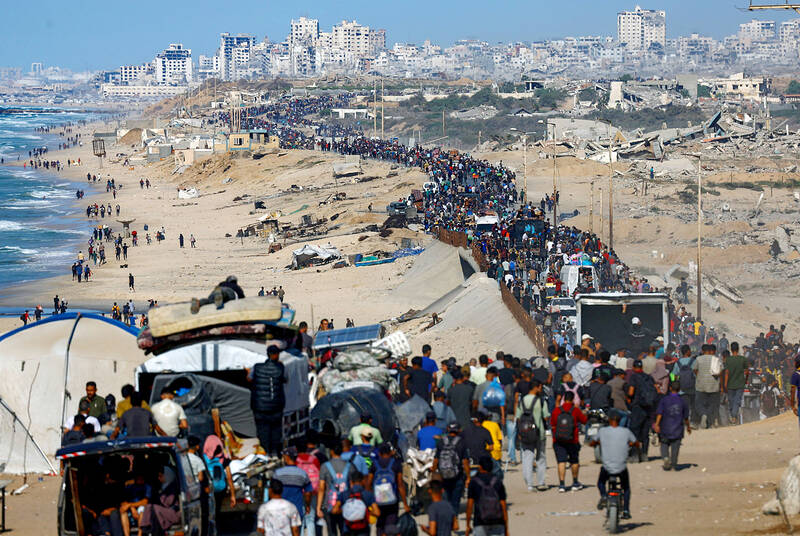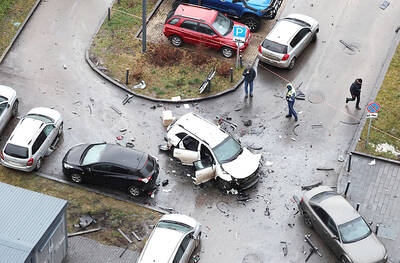A ceasefire between Israel and Hamas came into effect in Gaza yesterday, the Israeli military said, hours after Israel’s Cabinet approved a deal to pause the fighting and exchange the remaining hostages for Palestinian prisoners.
Tens of thousands of people who had gathered in Wadi Gaza in central Gaza in the morning started walking north after the military’s announcement at noon local time. Beforehand, Palestinians reported heavy shelling in parts of Gaza throughout yesterday morning, but no significant bombardment was reported after.
The ceasefire is a key step toward ending a ruinous two-year war that has killed tens of thousands of Palestinians, reduced much of Gaza to rubble, destabilized the Middle East, and left dozens of hostages, living and dead, in the territory.

Photo: Reuters
Still, the broader plan advanced by US President Donald Trump includes many unanswered questions, such as whether and how Hamas would disarm and who would govern Gaza.
A brief statement from Israeli Prime Minister Benjamin Netanyahu’s office early yesterday said the Israeli Cabinet approved the “outline” of a deal to release the hostages, without mentioning other aspects of the plan that are more controversial.
Israeli troops have begun to withdraw to agreed-upon deployment lines, the military said.
An Israeli security official, speaking on condition of anonymity due to the sensitivity of the withdrawal, said the military would control about 50 percent of Gaza in their new positions.
Senior Hamas official and lead negotiator Khalil al-Hayyas gave a speech on Thursday laying out what he said were the core elements of the ceasefire deal: Israel releasing about 2,000 Palestinian prisoners, opening the border crossing with Egypt, allowing aid to flow and Israeli forces withdrawing.
Khalil al-Hayya said all women and children held in Israeli jails would also be freed. He did not offer details on the extent of the Israeli withdrawal from Gaza.
A list published yesterday by Israel of Palestinian prisoners to be released as part of the deal did not include high-profile prisoner Marwan Barghouti, the most popular Palestinian leader and a potentially unifying figure. Israel views some others as terrorist masterminds who murdered Israeli civilians and has refused to release them in past exchanges.
The Trump administration and mediators had given assurances that the war is over, al-Hayya said, adding that Hamas and other Palestinian factions would now focus on achieving self-determination and establishing a Palestinian state.
To help support and monitor the ceasefire deal, US officials said they would send about 200 troops to Israel as part of a broader, international team.
The officials spoke on condition of anonymity to discuss details not authorized for release.

A car bomb killed a senior Russian general in southern Moscow yesterday morning, the latest high-profile army figure to be blown up in a blast that came just hours after Russian and Ukrainian delegates held separate talks in Miami on a plan to end the war. Kyiv has not commented on the incident, but Russian investigators said they were probing whether the blast was “linked” to “Ukrainian special forces.” The attack was similar to other assassinations of generals and pro-war figures that have either been claimed, or are widely believed to have been orchestrated, by Ukraine. Russian Lieutenant General Fanil Sarvarov, 56, head

SAFETY FIRST: Double the number of police were deployed at the Taipei Marathon, while other cities released plans to bolster public event safety Authorities across Taiwan have stepped up security measures ahead of Christmas and New Year events, following a knife and smoke bomb attack in Taipei on Friday that left four people dead and 11 injured. In a bid to prevent potential copycat incidents, police deployments have been expanded for large gatherings, transport hubs, and other crowded public spaces, according to official statements from police and city authorities. Taipei Mayor Chiang Wan-an (蔣萬安) said the city has “comprehensively raised security readiness” in crowded areas, increased police deployments with armed officers, and intensified patrols during weekends and nighttime hours. For large-scale events, security checkpoints and explosives

PUBLIC SAFETY: The premier said that security would be tightened in transport hubs, while President Lai commended the public for their bravery The government is to deploy more police, including rapid response units, in crowded public areas to ensure a swift response to any threats, President William Lai (賴清德) said yesterday after a knife attack killed three people and injured 11 in Taipei the previous day. Lai made the remarks following a briefing by the National Police Agency on the progress of the investigation, saying that the attack underscored the importance of cooperation in public security between the central and local governments. The attack unfolded in the early evening on Friday around Taipei Main Station’s M7 exit and later near the Taipei MRT’s Zhongshan

REBUFFED: In response to Chinese criticism over recent arms sales, Washington urged Beijing to engage in meaningful dialogue instead of threats and intimidation Washington’s long-term commitment to Taiwan would not change, the US Department of State said yesterday, urging Beijing to stop pressuring Taiwan and engage in meaningful bilateral dialogues. The remarks came in response to a backlash from Beijing about Washington’s latest approval of arms sales to Taiwan. The US Defense Security Cooperation Agency said in a statement on Wednesday that the Taipei Economic and Cultural Representative Office in the US has asked to purchase an arms package, including Tactical Mission Network Software; AH-1W helicopter spare and repair parts; M109A7 self-propelled howitzers; HIMARS long range precision strike systems; tube-launched, optically tracked, wire-guided missiles; Javelin